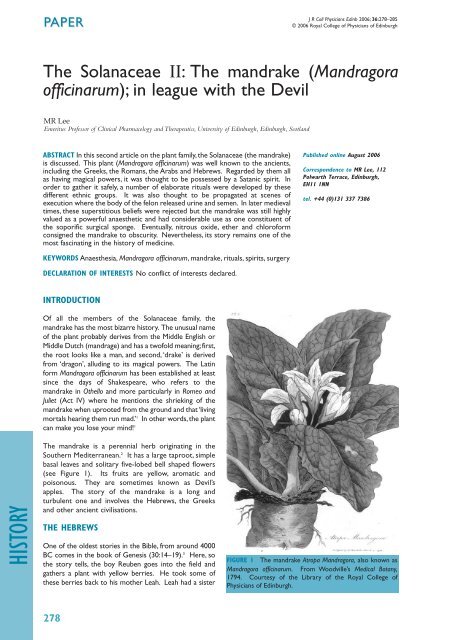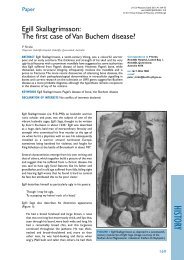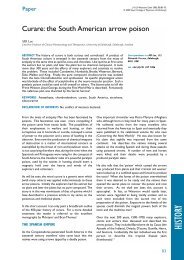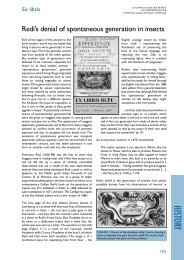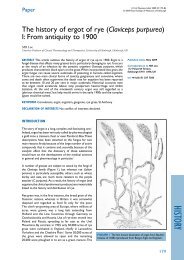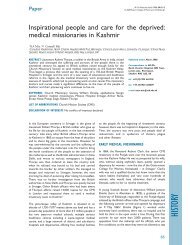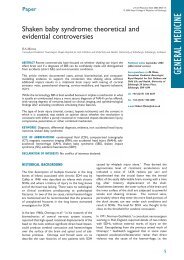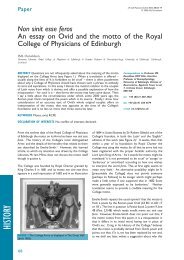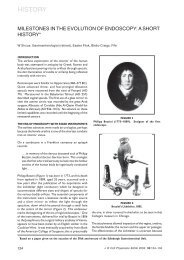The Solanaceae II: The mandrake (Mandragora officinarum); in ...
The Solanaceae II: The mandrake (Mandragora officinarum); in ...
The Solanaceae II: The mandrake (Mandragora officinarum); in ...
You also want an ePaper? Increase the reach of your titles
YUMPU automatically turns print PDFs into web optimized ePapers that Google loves.
HISTORY<br />
PAPER APER<br />
INTRODUCTION<br />
Of all the members of the <strong>Solanaceae</strong> family, the<br />
<strong>mandrake</strong> has the most bizarre history. <strong>The</strong> unusual name<br />
of the plant probably derives from the Middle English or<br />
Middle Dutch (mandrage) and has a twofold mean<strong>in</strong>g;first,<br />
the root looks like a man, and second, ‘drake’ is derived<br />
from ‘dragon’, allud<strong>in</strong>g to its magical powers. <strong>The</strong> Lat<strong>in</strong><br />
form <strong>Mandragora</strong> <strong>offic<strong>in</strong>arum</strong> has been established at least<br />
s<strong>in</strong>ce the days of Shakespeare, who refers to the<br />
<strong>mandrake</strong> <strong>in</strong> Othello and more particularly <strong>in</strong> Romeo and<br />
Juliet (Act IV) where he mentions the shriek<strong>in</strong>g of the<br />
<strong>mandrake</strong> when uprooted from the ground and that ‘liv<strong>in</strong>g<br />
mortals hear<strong>in</strong>g them run mad.’ 1 In other words, the plant<br />
can make you lose your m<strong>in</strong>d! 1<br />
<strong>The</strong> <strong>mandrake</strong> is a perennial herb orig<strong>in</strong>at<strong>in</strong>g <strong>in</strong> the<br />
Southern Mediterranean. 2 It has a large taproot, simple<br />
basal leaves and solitary five-lobed bell shaped flowers<br />
(see Figure 1). Its fruits are yellow, aromatic and<br />
poisonous. <strong>The</strong>y are sometimes known as Devil’s<br />
apples. <strong>The</strong> story of the <strong>mandrake</strong> is a long and<br />
turbulent one and <strong>in</strong>volves the Hebrews, the Greeks<br />
and other ancient civilisations.<br />
THE HEBREWS<br />
One of the oldest stories <strong>in</strong> the Bible, from around 4000<br />
BC comes <strong>in</strong> the book of Genesis (30:14–19). 3 Here, so<br />
the story tells, the boy Reuben goes <strong>in</strong>to the field and<br />
gathers a plant with yellow berries. He took some of<br />
these berries back to his mother Leah. Leah had a sister<br />
278<br />
J R Coll Physicians Ed<strong>in</strong>b 2006; 36:278–285<br />
© 2006 Royal College of Physicians of Ed<strong>in</strong>burgh<br />
<strong>The</strong> <strong>Solanaceae</strong> <strong>II</strong>: <strong>The</strong> <strong>mandrake</strong> (<strong>Mandragora</strong><br />
<strong>offic<strong>in</strong>arum</strong>); <strong>in</strong> league with the Devil<br />
MR Lee<br />
Emeritus Professor of Cl<strong>in</strong>ical Pharmacology and <strong>The</strong>rapeutics, University of Ed<strong>in</strong>burgh, Ed<strong>in</strong>burgh, Scotland<br />
ABSTRACT In this second article on the plant family, the <strong>Solanaceae</strong> (the <strong>mandrake</strong>)<br />
is discussed. This plant (<strong>Mandragora</strong> <strong>offic<strong>in</strong>arum</strong>) was well known to the ancients,<br />
<strong>in</strong>clud<strong>in</strong>g the Greeks, the Romans, the Arabs and Hebrews. Regarded by them all<br />
as hav<strong>in</strong>g magical powers, it was thought to be possessed by a Satanic spirit. In<br />
order to gather it safely, a number of elaborate rituals were developed by these<br />
different ethnic groups. It was also thought to be propagated at scenes of<br />
execution where the body of the felon released ur<strong>in</strong>e and semen. In later medieval<br />
times, these superstitious beliefs were rejected but the <strong>mandrake</strong> was still highly<br />
valued as a powerful anaesthetic and had considerable use as one constituent of<br />
the soporific surgical sponge. Eventually, nitrous oxide, ether and chloroform<br />
consigned the <strong>mandrake</strong> to obscurity. Nevertheless, its story rema<strong>in</strong>s one of the<br />
most fasc<strong>in</strong>at<strong>in</strong>g <strong>in</strong> the history of medic<strong>in</strong>e.<br />
KEYWORDS Anaesthesia, <strong>Mandragora</strong> <strong>offic<strong>in</strong>arum</strong>, <strong>mandrake</strong>, rituals, spirits, surgery<br />
DECLARATION OF INTERESTS No conflict of <strong>in</strong>terests declared.<br />
Published onl<strong>in</strong>e August 2006<br />
Correspondence to MR Lee, 112<br />
Polwarth Terrace, Ed<strong>in</strong>burgh,<br />
EH11 1NN<br />
tel. +44 (0)131 337 7386<br />
FIGURE 1 <strong>The</strong> <strong>mandrake</strong> Atropa <strong>Mandragora</strong>, also known as<br />
<strong>Mandragora</strong> <strong>offic<strong>in</strong>arum</strong>. From Woodville’s Medical Botany,<br />
1794. Courtesy of the Library of the Royal College of<br />
Physicians of Ed<strong>in</strong>burgh.
called Rachel and she, recognis<strong>in</strong>g the fruit as that of the<br />
<strong>mandrake</strong>, requested some say<strong>in</strong>g, <strong>in</strong> the words of the<br />
K<strong>in</strong>g James version of the Bible, ‘Give me I pray of thy<br />
son’s <strong>mandrake</strong>s.’<br />
Rachel was barren and she sought to correct the ancient<br />
severe stigma of childlessness with the <strong>mandrake</strong>. Leah<br />
struck a barga<strong>in</strong> with Rachel that if she should give her<br />
some of the <strong>mandrake</strong> berries (or fruits) then Leah’s<br />
husband must sleep with Leah first before sleep<strong>in</strong>g with<br />
Rachel. Both women became pregnant; Leah bore her fifth<br />
son Issachar and some time later Rachel gave birth to<br />
Joseph who was to play an illustrious part <strong>in</strong> Jewish history. 4<br />
Interest<strong>in</strong>gly, the emphasis amongst the Jews was on the<br />
power of the plant to aid the procreation of offspr<strong>in</strong>g and<br />
there is no mention of its narcotic power. <strong>The</strong> ancient<br />
Greeks sometimes referred to the fruit as the ‘apples of<br />
love’ whereas the Arabs, by contrast, called them the<br />
‘Devil’s apples’ from their capacity to <strong>in</strong>flame the passions.<br />
In the neighbourhood of Mount Lebanon, some of the<br />
Arab tribes called the plant ‘Baid-ul-J<strong>in</strong>n’ or literally ‘the<br />
eggs of the Genii’ and this is one of the first references to<br />
its so called ‘magical’ powers.<br />
THE GREEKS AND ROMANS<br />
<strong>The</strong> Greeks came to the <strong>mandrake</strong> from a different<br />
direction. 5 For as long as they had records of the plant, it<br />
was known to have narcotic properties. Hippocrates, the<br />
Father of Medic<strong>in</strong>e, asserted around 400 BC that ‘a small<br />
dose <strong>in</strong> w<strong>in</strong>e, less than would occasion delirium, will<br />
relieve the deepest depression and anxiety.’ Aristotle<br />
describes the <strong>mandrake</strong> as a valuable soporific, together<br />
with other plants such as the poppy (Papaver species) and<br />
the darnel (tares; Lolium temulentum).<br />
<strong>The</strong>ophrastus wrote the first Greek treatise on plants <strong>in</strong> or<br />
around 230 BC. In agreement with the polypharmacy of the<br />
time, he recommended the <strong>mandrake</strong> as a sovereign<br />
remedy for gout, erysipelas, sleeplessness and, <strong>in</strong>terest<strong>in</strong>gly,<br />
<strong>in</strong> relation to the Hebraic tradition,as a love potion. He also<br />
refers to the fact that the taproot of the plant resembles a<br />
dim<strong>in</strong>utive man,and it was from such early observations that<br />
the bizarre rites and ceremonies surround<strong>in</strong>g the plant were<br />
to emerge <strong>in</strong> the centuries that followed.<br />
As far as the love potion is concerned, the Greeks also<br />
associated the plant with two important mythological<br />
figures, Circe and Aphrodite. Circe was reputed to have<br />
attempted to bewitch Odysseus with the <strong>mandrake</strong><br />
although fortunately he had taken a preventive antidote<br />
that could have been the snowdrop (Galanthus). Similarly,<br />
Aphrodite the goddess of love was sometimes known as<br />
Mandragoritis or ‘She of the Mandrake’.<br />
In <strong>The</strong>ophrastus’ treatise, we have the first clear<br />
description of the procedure that must be followed by the<br />
J R Coll Physicians Ed<strong>in</strong>b 2006; 36:278–285<br />
© 2006 RCPE<br />
plant gatherer <strong>in</strong> order that he should not be bewitched<br />
by the <strong>mandrake</strong>. <strong>The</strong> operator should draw three circles<br />
around the plant with his sword. <strong>The</strong>n, fac<strong>in</strong>g the west to<br />
avoid evil spells, he should slice portions off the taproot.<br />
At the cutt<strong>in</strong>g of the second piece, he must dance around<br />
the plant and mutter <strong>in</strong>cantations concern<strong>in</strong>g the mystery<br />
of love. Draw<strong>in</strong>g the three circles around the plant<br />
protects the operative from the plant and the sword used<br />
should be a ‘magic’ one made of virg<strong>in</strong> iron and only ever<br />
used for the purpose of <strong>mandrake</strong> gather<strong>in</strong>g. Similar<br />
magical rites were recommended for gather<strong>in</strong>g other<br />
herbs, such as the Belladonna and All Heal (see Figure 2).<br />
<strong>The</strong> next important authority who was to pay particular<br />
attention to the <strong>mandrake</strong> was the man who became<br />
known as the Father of Pharmacy, Pedanius Dioscorides<br />
of Anazaba. Born <strong>in</strong> Silesia, he travelled extensively<br />
through the whole of Southern Europe for a period of<br />
almost fifty years, start<strong>in</strong>g about AD 40. He <strong>in</strong>vestigated<br />
more than six hundred herbs and recorded his results <strong>in</strong><br />
a manuscript entitled the Anicia, a copy of which is<br />
preserved <strong>in</strong> the Imperial Library at Vienna. In the book<br />
are two full page m<strong>in</strong>iatures devoted to the plant. In the<br />
first Euresis, the goddess of discovery offers the author<br />
Dioscorides a specimen of the <strong>mandrake</strong> root. Also seen<br />
<strong>in</strong> the picture is a dog that has succumbed to the evil<br />
effects of the plant. In the second m<strong>in</strong>iature, he is shown<br />
draw<strong>in</strong>g the root of the <strong>mandrake</strong>.<br />
Dioscorides mentions a number of other names that have<br />
been used for the herb but suggests firmly that<br />
<strong>Mandragora</strong> should be adopted. He also notes that there<br />
are ‘male’ and ‘female’ forms but it is not clear what he<br />
means by this. Moreover, he confirms the views of<br />
<strong>The</strong>ophrastus that the root and fruit (berries) are useful<br />
for a wide variety of illnesses and perhaps as a love potion<br />
or fertility drug.<br />
THE ROMAN TRADITION<br />
<strong>The</strong> <strong>Solanaceae</strong> <strong>II</strong>: the <strong>mandrake</strong><br />
From 500 BC onwards physicians and philosophers<br />
migrated from Greece to Rome and took with them the<br />
knowledge that they had acquired from the early disciples<br />
of Asklepios (<strong>in</strong>clud<strong>in</strong>g <strong>The</strong>ophrastus and Dioscorides).<br />
<strong>The</strong> first Roman author to take up the <strong>mandrake</strong><br />
appears to be Pl<strong>in</strong>y the Elder. 6 Writ<strong>in</strong>g <strong>in</strong> the first<br />
century AD, he commends it for all the usual ailments<br />
cited above. He adds the additional <strong>in</strong>dication that it is<br />
useful for the condition of <strong>in</strong>flammation of the eyes. He<br />
also concluded that there are two varieties of the<br />
mandake, vernalis (flower<strong>in</strong>g <strong>in</strong> the spr<strong>in</strong>g) and autumnalis<br />
(flower<strong>in</strong>g <strong>in</strong> the autumn) but this has not been<br />
confirmed by modern studies.<br />
<strong>The</strong> Romans also believed that the plant might be used for<br />
military as well as medic<strong>in</strong>al purposes. Two stories<br />
circulated widely amongst the Roman high command. <strong>The</strong><br />
279<br />
HISTORY
HISTORY<br />
MR Lee<br />
FIGURE 2 Dog Uproot<strong>in</strong>g a <strong>mandrake</strong>. Reproduced from a<br />
fourteenth century manuscript.<br />
first related to the Carthag<strong>in</strong>ian general Hannibal who,<br />
when his army was fight<strong>in</strong>g African rebels, pretended to<br />
retreat. He then left beh<strong>in</strong>d on the battlefield a number<br />
of jars of w<strong>in</strong>e which had been fortified with <strong>mandrake</strong>.<br />
<strong>The</strong> rebels drank the w<strong>in</strong>e, became sleepy, or even<br />
stuporose, and were easily defeated. It was also said that<br />
Julius Caesar, when he was captured by Sicilian pirates,<br />
employed a similar stratagem to ga<strong>in</strong> his release.<br />
THE MANDRAKE GAINS ENTRY TO BRITAIN<br />
After the fall of the Roman Empire and the so-called<br />
Dark Ages, little is heard of the <strong>mandrake</strong> <strong>in</strong> Europe (or<br />
Brita<strong>in</strong>) until the Anglo-Saxon period. 7 <strong>The</strong>n, at the end<br />
of the first millennium, Apuleius produced his famous<br />
Herbarium Platonicus and this was translated <strong>in</strong>to Anglo-<br />
Saxon. In the native language, the <strong>mandrake</strong> is described<br />
as ‘mickle’ (very) beneficial for all sorts of ailments. He<br />
notes that at night, the leaves sh<strong>in</strong>e together like a lamp,<br />
and that this signifies supernatural possession. <strong>The</strong><br />
Greek’s previous <strong>in</strong>structions <strong>in</strong> regard to harvest<strong>in</strong>g<br />
were modified <strong>in</strong> two important ways. Firstly, <strong>in</strong>stead of<br />
the man digg<strong>in</strong>g up the root(s) himself, a dog should be<br />
used to jerk it from the ground (see Figure 2). Secondly,<br />
an ivory staff should be used to loosen them (ivory was<br />
protected from evil). As with the Greeks, an iron sword<br />
was then used to cut them <strong>in</strong>to manageable portions. All<br />
this was, as far as possible, to avoid the contam<strong>in</strong>ation of<br />
the gatherer by the malign evil spirit that lived <strong>in</strong> the<br />
plant. However, if the plant was pulled from the ground<br />
at certa<strong>in</strong> holy seasons, the evil spirit would appear to<br />
the gatherer and do his bidd<strong>in</strong>g. This is very rem<strong>in</strong>iscent<br />
of the Arab belief, referred to <strong>in</strong> an earlier section, that<br />
280<br />
FIGURE 3 Bryonia Alba: the White Briony is one of the ‘false’<br />
<strong>mandrake</strong>s. From Woodville’s Medical Botany, 1794. Courtesy<br />
of the Royal College of Physicians of Ed<strong>in</strong>burgh.<br />
the plant was occupied by dj<strong>in</strong>ns (spirits) who could<br />
work for good or evil.<br />
<strong>The</strong> <strong>mandrake</strong> was not <strong>in</strong>digenous to Brita<strong>in</strong>.<br />
Consequently, its dried roots had to be imported, often at<br />
great expense. <strong>The</strong> root <strong>in</strong> its native form (or as a carved<br />
manik<strong>in</strong> or homunculus) became a prized family heirloom<br />
and was often bequeathed specifically <strong>in</strong> wills. As a result<br />
of the rarety and value of <strong>Mandragora</strong>, a search was made<br />
for native plants that could act, or <strong>in</strong>deed be passed off, as<br />
a poor man’s substitute. <strong>The</strong> plants that the medieval<br />
herbalists came up with were the black and white brionies<br />
(see Figure 3). 8 <strong>The</strong> roots of both these plants resemble<br />
those of the <strong>mandrake</strong>. <strong>The</strong>y can be carved as a<br />
homunculus and both conta<strong>in</strong> narcotic poisons. (see<br />
Figure 3). All this illustrates that between the period 1200<br />
to 1600 there was a very considerable trade <strong>in</strong> Brita<strong>in</strong><br />
(and Europe) <strong>in</strong> the <strong>mandrake</strong> and ersatz substitutes.<br />
CEREMONIES THAT SURROUND THE<br />
GATHERING OF THE MANDRAKE AND SIMILAR<br />
MAGICAL PLANTS<br />
Curious and mysterious ceremonies surround the<br />
gather<strong>in</strong>g of the <strong>mandrake</strong>. Why did the <strong>mandrake</strong><br />
generate such a love/hate relationship with the local<br />
peasants? On the one hand, they were desperate to get<br />
hold of the root because it gave them power, <strong>in</strong>fluence<br />
and <strong>in</strong>deed wealth. On the other hand, they were scared<br />
J R Coll Physicians Ed<strong>in</strong>b 2006; 36:278–285<br />
© 2006 RCPE
witless that <strong>in</strong> the course of harvest<strong>in</strong>g (or handl<strong>in</strong>g) the<br />
root they would be struck down dead, or alternatively,<br />
possessed by an evil Satanic spirit that would force them<br />
to commit unspeakable s<strong>in</strong>s, condemn<strong>in</strong>g them to hellfire<br />
and damnation.<br />
<strong>The</strong>refore magic must be met by more powerful magic.<br />
First came the ritual of the Greeks who drew special<br />
circles around the plant while fac<strong>in</strong>g west to placate the<br />
Chthonic gods. <strong>The</strong>n <strong>in</strong> the Christian era came the dog.<br />
This acted as a classical scapegoat and it was hoped that<br />
the evil spirit would pass <strong>in</strong>to the unfortunate animal as<br />
the root was harvested.<br />
<strong>The</strong> dog would be fasted for several days to get it <strong>in</strong> the<br />
right state of m<strong>in</strong>d (extreme hunger)! It was then tied<br />
by strong cords to the stem of the plant. Pieces of meat<br />
were thrown just out of its reach. In its agitation to get<br />
someth<strong>in</strong>g to eat the dog would haul the dreaded plant<br />
out of the ground. <strong>The</strong> dog died (or may have been put<br />
to death) at the spot where the <strong>mandrake</strong> was<br />
unearthed. <strong>The</strong>n, with the appropriate <strong>in</strong>cantations, the<br />
evil spirit passes back from the dog <strong>in</strong>to the ground. As<br />
time went on various modifications (and amplifications)<br />
were <strong>in</strong>troduced, described by Aelian <strong>in</strong> his book De<br />
Natura Animalium.<br />
For example, it is stated that the diggers must only go out<br />
on the day of Venus (Friday). Also because the <strong>mandrake</strong><br />
may emit wild terrify<strong>in</strong>g shrieks which could send the<br />
gatherers mad they must plug their ears with pitch (or<br />
wax). A crucifix was affixed to the plant before it was<br />
disturbed <strong>in</strong> order to subdue the evil spirit.<br />
<strong>The</strong> day, the hour and the season of the year were all<br />
important to the diggers, both to ensure the efficacy of<br />
the root extracted and the safety of gatherers. <strong>The</strong> hour<br />
preferred was before sunrise because at that time the<br />
plant was said to be most active <strong>in</strong> produc<strong>in</strong>g its magical<br />
pr<strong>in</strong>ciples and the evil spirit guard<strong>in</strong>g them was likely to be<br />
asleep. Mandrake was needed both as a love potion and<br />
a means of ensur<strong>in</strong>g fertility.<br />
Certa<strong>in</strong> seasons of the year were more successful than<br />
others for the gather<strong>in</strong>g of the plant <strong>in</strong>clud<strong>in</strong>g <strong>in</strong> particular<br />
Midsummer Day (or the follow<strong>in</strong>g night). This was the day<br />
traditionally dedicated to St John the Baptist (25 June) and<br />
as Lee has po<strong>in</strong>ted out was also the preferred time for<br />
harvest<strong>in</strong>g Hypericum perforatum (St John’s Wort)<br />
another sacred plant. 9<br />
It should be made clear that many magical and medic<strong>in</strong>al<br />
plants had similar ceremonies associated with their<br />
gather<strong>in</strong>g but without the dog. Apart from St John’s<br />
Wort, they <strong>in</strong>cluded Valerian, Selago and the Peony.<br />
Common rites <strong>in</strong>cluded the recit<strong>in</strong>g of the Pater Noster,<br />
Ave Maria, the Apostles’ Creed and selected portions of<br />
St John’s Gospel.<br />
J R Coll Physicians Ed<strong>in</strong>b 2006; 36:278–285<br />
© 2006 RCPE<br />
<strong>The</strong> <strong>Solanaceae</strong> <strong>II</strong>: the <strong>mandrake</strong><br />
<strong>The</strong> historic <strong>in</strong>structions conclude with show<strong>in</strong>g due<br />
reverence to the root. First, it should be placed <strong>in</strong> a<br />
runn<strong>in</strong>g stream for a day and a night to take away the ta<strong>in</strong>t<br />
(or sta<strong>in</strong>) of the Devil. <strong>The</strong>n it should be wrapped <strong>in</strong> a<br />
clean white l<strong>in</strong>en cloth and stored with care. It should be<br />
placed <strong>in</strong> a secure wooden box and when brought out for<br />
the adm<strong>in</strong>istration of spells appropriate prayers should<br />
always be said. In some ways, the handl<strong>in</strong>g of <strong>mandrake</strong><br />
resembles the treatment of the relics of the Sa<strong>in</strong>ts.<br />
THE MANDRAKE AND THE GALLOWS<br />
As if these superstitions and practices were not enough,<br />
another myth grew up and became established between<br />
the fifteenth and eighteenth centuries. 10 This story<br />
became particularly widespread <strong>in</strong> Germany and Austria<br />
where they believed that if a crim<strong>in</strong>al had been buried or<br />
hanged at a particular spot, then there would the<br />
<strong>mandrake</strong> grow and flourish. Schmidel, <strong>in</strong> 1751, described<br />
the situation as follows: ‘At the foot of the gallows on<br />
which a man has been hanged and where ur<strong>in</strong>e has been<br />
voided at the time of death, there spr<strong>in</strong>gs up a plant with<br />
broad leaves and a yellow flower. <strong>The</strong> root of the plant<br />
exactly represents the human form, from the hair of his<br />
head to the sexual organs.’ <strong>The</strong>se roots were highly<br />
prized <strong>in</strong> Germany and changed hands at <strong>in</strong>flated prices.<br />
<strong>The</strong>y were known to the populace as the Galgemannle<strong>in</strong>,<br />
or the ‘little gallows man’ and represented the congealed<br />
ur<strong>in</strong>e and semen of the executed crim<strong>in</strong>al!<br />
<strong>The</strong> German <strong>in</strong>structions for the care of the ‘little<br />
gallows man’ were very specific. ‘Wash him clean <strong>in</strong> red<br />
w<strong>in</strong>e and then wrap him <strong>in</strong> layers of white and red silk.<br />
Lay him <strong>in</strong> a casket and do not forget firstly to bathe him<br />
every Friday (the day of Venus aga<strong>in</strong>) and secondly and<br />
most importantly at the new moon to clothe him <strong>in</strong> a<br />
clean white shirt.’<br />
If treated and respected <strong>in</strong> this way the gallows man<br />
ensures that you will be rich and fertile. Moreover he will<br />
answer any questions that you address to him (compare<br />
the genie of the Devil’s Apple). When the owner of this<br />
precious heirloom died, the homunculus should be passed<br />
on, not to the eldest but to the youngest son.<br />
<strong>The</strong> myth of the <strong>mandrake</strong> sprout<strong>in</strong>g at the site of the<br />
gibbet watered and fertilized by ur<strong>in</strong>e and semen has<br />
many parallels <strong>in</strong> other cultures. <strong>The</strong> first comes <strong>in</strong><br />
Greek mythology when the flesh eat<strong>in</strong>g eagle spills the<br />
blood of Prometheus on the ground. From the area<br />
where the blood had spilt a plant emerged which was<br />
identified later as the Corycian crocus. Similar stories<br />
have also emerged <strong>in</strong> relation to the dead bodies of<br />
Mexicans and the marigold; and also Danish soldiers and<br />
the Dane weed. F<strong>in</strong>ally <strong>in</strong> modern times we remember<br />
the red poppies that flourished on the battlefields of<br />
Waterloo and Flanders that have come to assume semimythological<br />
status.<br />
281<br />
HISTORY
HISTORY<br />
MR Lee<br />
THE MANDRAKE IN ENGLISH LITERATURE<br />
In the light of the long, ancient and bizarre history of the<br />
<strong>mandrake</strong>, it is no surprise that the plant should have been<br />
taken up by poets, dramatists and romantic novelists.<br />
<strong>The</strong>re is only space here to refer to a few strik<strong>in</strong>g<br />
examples. For a more extensive coverage the reader is<br />
referred to Thompson’s excellent treatise. 11<br />
By the time of Shakespeare, the root was imported<br />
widely and also cheaper alternatives, such as the<br />
white and black briony were available. <strong>The</strong> Bard of<br />
Avon makes a number of references to the root.<br />
Falstaff alludes twice to its effects on sexual<br />
performance <strong>in</strong> Henry IV Part <strong>II</strong> – first he addresses his<br />
page as ‘Thou whoresom <strong>mandrake</strong>’ and then<br />
condemns Justice Swallow as ‘the very genius of<br />
fam<strong>in</strong>e; yet lecherous as a monkey and the whores call<br />
him <strong>mandrake</strong>’ (Act I, Scene 2, and Act <strong>II</strong>I, Scene 2<br />
respectively). One of the most celebrated references<br />
to the plant is that <strong>in</strong> Othello (Act <strong>II</strong>I, Scene 8) where<br />
Iago referr<strong>in</strong>g to its narcotic qualities says ‘Not poppy<br />
nor mandragora; nor all the drowsy syrups of the<br />
world; shall ever medic<strong>in</strong>e thee to that sweet sleep<br />
which thou owdst yesterday.’<br />
<strong>The</strong> <strong>mandrake</strong>’s shriek<strong>in</strong>g on extraction is referred to <strong>in</strong><br />
Henry VI (Act <strong>II</strong>I, Scene 2) where Suffolk says:<br />
282<br />
‘Would curses kill as doth the <strong>mandrake</strong>’s groan<br />
I would <strong>in</strong>vent as bitter search<strong>in</strong>g terms<br />
As curst, as harsh and horrible to hear.’<br />
Other authors took up the mysterious herb <strong>in</strong>clud<strong>in</strong>g<br />
Marlowe and Drayton. In his popular play, <strong>The</strong> Jew of<br />
Malta, Marlowe causes Barabas to expla<strong>in</strong> how he escaped<br />
from prison by say<strong>in</strong>g:<br />
‘I drank poppy and cold <strong>mandrake</strong> juice;<br />
and be<strong>in</strong>g asleep belike they thought me dead<br />
And threw me over the walls.’<br />
This emphasises the prolonged sleep that <strong>mandrake</strong> can<br />
br<strong>in</strong>g on <strong>in</strong> which the <strong>in</strong>dividual can appear <strong>in</strong>sensible to<br />
pa<strong>in</strong> and almost ‘dead’.<br />
Michael Drayton, the Elizabethan poet was also well<br />
aware of the many properties of <strong>mandrake</strong> and <strong>in</strong> his<br />
work the Polyolbian refers to its association with the<br />
mistletoe, a plant sacred to the Druids. He may here have<br />
been confus<strong>in</strong>g it with the false <strong>mandrake</strong>s; the white or<br />
black briony. Plants grow<strong>in</strong>g under the mistletoe like<br />
‘<strong>mandrake</strong>’, such as cyclamen, purslane and valerian were<br />
all believed to <strong>in</strong>spire love.<br />
Dur<strong>in</strong>g the eighteenth and n<strong>in</strong>eteenth century, references<br />
to the <strong>mandrake</strong> decl<strong>in</strong>e steadily and by 1850 have all but<br />
disappeared. Perhaps the f<strong>in</strong>al quotation I should make is<br />
that from the Irish poet Thomas Moore (1779–1852) who<br />
<strong>in</strong> his epic poem Lalla Rookh says:<br />
‘Such rank and deadly lustre dwells<br />
As <strong>in</strong> these hellish fires that light<br />
<strong>The</strong> <strong>mandrake</strong>’s charnel leaves at night.’<br />
Also known as the Devil’s candle to the Arabs, why the<br />
<strong>mandrake</strong>’s leaves should glow at night has rema<strong>in</strong>ed a<br />
mystery. Once thought to be demonic possession a more<br />
prosaic explanation is that its scent attracted glowworms<br />
<strong>in</strong> the hot Eastern climes.<br />
THE SCEPTICAL HERBALISTS 1500 TO 1800<br />
As time went on <strong>in</strong>to the sixteenth and seventeenth<br />
centuries there came <strong>in</strong> turn the New Age of Herbalism;<br />
the era of rationalism and the Enlightenment. 12 Mandrake<br />
gather<strong>in</strong>g and its usage was submitted to question<strong>in</strong>g and<br />
analysis. Superstitions were jettisoned but therapeutic<br />
use ma<strong>in</strong>ta<strong>in</strong>ed.<br />
One of the most <strong>in</strong>terest<strong>in</strong>g early accounts <strong>in</strong> this<br />
period is that by William Turner, Dean of Wells<br />
Cathedral and Doctor of Physick, pr<strong>in</strong>ted <strong>in</strong> 1551. He<br />
describes the male and female forms of the roots but<br />
condemns the fact that manik<strong>in</strong>s (male) and puppettes<br />
(the female forms) are carved from the plants and sold<br />
to the credulous common people. ‘<strong>The</strong>y are thus<br />
deprived both of their wits and their money!’ He also<br />
condemns the legend relat<strong>in</strong>g to the gallows man as<br />
superstitious nonsense!<br />
However he does not abandon the <strong>mandrake</strong> completely,<br />
recommend<strong>in</strong>g it particularly as a soporific, pa<strong>in</strong>killer and<br />
to dull the agony of ‘burn<strong>in</strong>g’ and ‘cutt<strong>in</strong>g’. He also noted<br />
that taken <strong>in</strong>to the mouth it could cause numbness of the<br />
oral cavity and tongue (see Richardson later.)<br />
<strong>The</strong> next important account was that of John Gerarde (<strong>in</strong><br />
his famous Herbal of 1597) <strong>in</strong> which he also castigates the<br />
prevalent folk tales as be<strong>in</strong>g propagated by ‘old wives,<br />
runagate surgeons or physickmongers!’ He describes the<br />
tales of the gallows man and the rites practised <strong>in</strong> digg<strong>in</strong>g<br />
up the <strong>mandrake</strong> as ‘doltish errors.’ He also attacks the<br />
use of Brione (brionies <strong>in</strong> the modern parlance) as<br />
practised by ‘idle drones’ who carve out mannik<strong>in</strong>s from<br />
these plants and then pass these off to superstitious<br />
people as the true <strong>mandrake</strong>.<br />
<strong>The</strong> next <strong>in</strong>fluential authority to rail aga<strong>in</strong>st the <strong>mandrake</strong><br />
was John Park<strong>in</strong>son, by Royal Appo<strong>in</strong>tment Herbalist to<br />
the Court of Charles the First. He discusses the plant <strong>in</strong><br />
some detail <strong>in</strong> his book A Garden of Pleasant Flowers<br />
(1629). He blamed the chief magistrates of the City of<br />
London for tolerat<strong>in</strong>g the sale of <strong>mandrake</strong> mannik<strong>in</strong>s. He<br />
urged them to prosecute the vendors of such ‘toys which<br />
are the ridiculous products of man’s <strong>in</strong>vention.’<br />
J R Coll Physicians Ed<strong>in</strong>b 2006; 36:278–285<br />
© 2006 RCPE
It should be noted here that the herbalists while<br />
describ<strong>in</strong>g the harvest<strong>in</strong>g rites (and the mannik<strong>in</strong>s) as<br />
superstitious nonsense still accepted that the <strong>mandrake</strong><br />
was sedative and anaesthetic. Moreover it could be used<br />
externally with benefit <strong>in</strong> such conditions as erysipelas,<br />
eye <strong>in</strong>fections and scrofulous tumours. Moreover any<br />
undesirable effects could be reversed by wormwood, rue,<br />
origanum or castor oil.<br />
MANDRAKE AND THE HISTORY OF<br />
ANAESTHESIA<br />
<strong>The</strong> soporific and anaesthetic properties of the <strong>mandrake</strong><br />
had been described by the classical authors over many<br />
centuries. 13 Such authorities <strong>in</strong>cluded Socrates,<br />
Demosthenes, Macrobius and <strong>The</strong>odoretus.<br />
In particular, Dioscorides outl<strong>in</strong>es the process by<br />
which strips of <strong>mandrake</strong> bark were allowed to be<br />
steeped <strong>in</strong> sweet w<strong>in</strong>e for months. This w<strong>in</strong>e<br />
conta<strong>in</strong>ed the narcotic pr<strong>in</strong>ciple and became known <strong>in</strong><br />
Roman times as the death w<strong>in</strong>e or ‘morion’. It was<br />
given to the victims of torture or crucifixion.<br />
Sometimes another bitter anaesthetic was added to<br />
the <strong>mandrake</strong> to potentiate its effects for example<br />
myrrh (Commiphora myrrha).<br />
<strong>The</strong> next important step <strong>in</strong> development was that of<br />
the ‘sleep<strong>in</strong>g sponge’ or spongia somnifera. Hugo de<br />
Lucca was the chief of a school of surgeons <strong>in</strong> Tuscany<br />
<strong>in</strong> the fifteenth century. In 1490, he devised this<br />
sponge, soaked <strong>in</strong> a mixture of herbs, which could be<br />
used as an <strong>in</strong>halational anaesthetic. <strong>The</strong> preparation<br />
conta<strong>in</strong>ed an <strong>in</strong>fusion of the follow<strong>in</strong>g plants: opium,<br />
mulberry, henbane, hemlock, <strong>mandrake</strong> and the seeds<br />
of lettuce, dock and water hemlock. In other words, at<br />
the very least it conta<strong>in</strong>ed morph<strong>in</strong>e, hyosc<strong>in</strong>e, and the<br />
alkaloids of <strong>mandrake</strong> (see below). Not surpris<strong>in</strong>gly,<br />
sleep could last for up to four hours (or even longer).<br />
This narcotic sponge was used over several centuries<br />
with good effect.<br />
One of the most dramatic stories of the use of such a<br />
sponge (conta<strong>in</strong><strong>in</strong>g <strong>mandrake</strong>) was <strong>in</strong> 1782 when Doctor<br />
Weiss, Court Surgeon to Augustus, K<strong>in</strong>g of Poland,<br />
adm<strong>in</strong>istered such an <strong>in</strong>halation to his patron render<strong>in</strong>g<br />
him <strong>in</strong>sensible. He then cut off part of his mortify<strong>in</strong>g foot<br />
and the K<strong>in</strong>g made a good recovery!<br />
However, the soporific sponge could prove<br />
unpredictable <strong>in</strong> its effects. Sometimes it did not work<br />
well at all and had to be supplemented by alcoholic<br />
spirits such as brandy (or whisky) and sometimes it<br />
worked too well and the patient never rega<strong>in</strong>ed<br />
consciousness. Many surgeons, <strong>in</strong> the period 1750 to<br />
1840, relied on physical restra<strong>in</strong>t of the patient and<br />
lightn<strong>in</strong>g fast technique and the poppy was the only drug<br />
used for post-operative pa<strong>in</strong>.<br />
J R Coll Physicians Ed<strong>in</strong>b 2006; 36:278–285<br />
© 2006 RCPE<br />
<strong>The</strong> <strong>Solanaceae</strong> <strong>II</strong>: the <strong>mandrake</strong><br />
WHY WAS MANDRAKE ABANDONED IN THE<br />
NINETEENTH CENTURY?<br />
As the n<strong>in</strong>eteenth century dawned, many doctors (and<br />
surgeons) were very dissatisfied with restra<strong>in</strong>t, alcohol<br />
and the soporific sponge, and began to <strong>in</strong>vestigate the<br />
possibilities of new <strong>in</strong>halational anaesthetics. 14<br />
<strong>The</strong> movement started with the great chemist Joseph<br />
Priestley <strong>in</strong> 1775 and his six volume series entitled<br />
Experiments and Observations on Different K<strong>in</strong>ds of Air. He<br />
was the first to isolate nitrous oxide (laugh<strong>in</strong>g gas) and<br />
this stimulated <strong>in</strong>terest eventually <strong>in</strong> diethyl ether<br />
(sulphuric ether) and chloroform. <strong>The</strong>se three volatile<br />
anaesthetics proved to be much more reliable and<br />
def<strong>in</strong>itely safer than those that had gone before. <strong>The</strong>re is<br />
no space here to discuss <strong>in</strong> detail the early development<br />
of effective <strong>in</strong>halational anaesthetics, but the reader is<br />
referred to the excellent monograph by Stratmann on<br />
Chloroform (<strong>The</strong> Quest for Oblivion). 14<br />
Suffice it to say that by 1850 these new excit<strong>in</strong>g agents<br />
had wiped away the soporific sponge (and <strong>mandrake</strong>) and<br />
they had become largely objects of historical curiosity.<br />
<strong>The</strong>re is one necessary footnote to the history of<br />
<strong>mandrake</strong>. It had been replaced by ether and chloroform<br />
for <strong>in</strong>halational anaesthesia but what of its other uses, as<br />
an oral analgesic for example?<br />
In 1888, Benjam<strong>in</strong> Ward Richardson began a series of<br />
<strong>in</strong>vestigations on the plant. 15 He procured a supply of<br />
the mandragora root from its native Greece and made a<br />
t<strong>in</strong>cture <strong>in</strong> an alcohol/water mixture for four weeks, thus<br />
reproduc<strong>in</strong>g the ancient recipe of Dioscorides. He<br />
found that this t<strong>in</strong>cture would sedate and anaesthetise<br />
animals particularly cats and dogs. He also noted that<br />
the pupils dilated and concluded that the extract must<br />
conta<strong>in</strong> an alkaloid (or alkaloids) similar to hyosc<strong>in</strong>e or<br />
atrop<strong>in</strong>e (most probably the former). He found also to<br />
his surprise that pigeons were much more sensitive to<br />
the <strong>in</strong>fusion than rabbits. We now know that rabbit gut<br />
(and liver) conta<strong>in</strong> an enzyme called atrop<strong>in</strong>ase which<br />
can destroy solanaceous alkaloids and allow this<br />
lagomorph to feed on nightshade (Atropa) and henbane<br />
(Hyoscyamus) and presumably also the <strong>mandrake</strong> with<br />
relative impunity.<br />
F<strong>in</strong>ally, Richardson tried small doses of the <strong>mandrake</strong><br />
<strong>in</strong>fusion on himself and noted the follow<strong>in</strong>g: numbness of<br />
the tongue; dryness of the mouth; confused vision;<br />
restlessness and exaggerated sensitivity to sounds. On<br />
the basis of these f<strong>in</strong>d<strong>in</strong>gs he concluded that if the alkaloid<br />
could be identified and extracted it might be used as an<br />
anaesthetic or possibly supercede atrop<strong>in</strong>e as a mydriatic.<br />
He also foresaw its use <strong>in</strong> strychn<strong>in</strong>e poison<strong>in</strong>g and lockjaw<br />
(tetanus). Richardson’s work was the first to apply<br />
proper scientific procedures to the <strong>mandrake</strong> and at the<br />
time provoked a great deal of <strong>in</strong>terest.<br />
283<br />
HISTORY
HISTORY<br />
MR Lee<br />
In 1889, Ahrens isolated an alkaloid from <strong>Mandragora</strong><br />
which he called ‘mandragor<strong>in</strong>e’. However, <strong>in</strong> 1901 Thoms<br />
and We<strong>in</strong>zel demonstrated that Ahren’s compound was <strong>in</strong><br />
fact a mixture of hyoscyam<strong>in</strong>e and hyosc<strong>in</strong>e together with<br />
a small amount of a third alkaloid for which they reta<strong>in</strong>ed<br />
the name mandragor<strong>in</strong>e. Despite this flurry of <strong>in</strong>terest <strong>in</strong><br />
the chemical constituents of <strong>mandrake</strong>, it was too late for<br />
the development of the plant. As we shall see <strong>in</strong> the next<br />
two articles <strong>in</strong> this series, hyosc<strong>in</strong>e and atrop<strong>in</strong>e were<br />
already characterised chemically by 1900 and com<strong>in</strong>g <strong>in</strong>to<br />
therapeutic use. Indeed they would be employed <strong>in</strong><br />
murder and attempted murder.<br />
FINAL THOUGHTS<br />
284<br />
‘<strong>The</strong> phantom shapes – oh touch not them –<br />
That appals the maiden’s sight,<br />
Lurk <strong>in</strong> the fleshy <strong>mandrake</strong>’s stem,<br />
That shrieks when pluckt at night!’<br />
Lalla Rookh<br />
by Thomas Moore (1779–1852)<br />
<strong>The</strong> history of the <strong>mandrake</strong> as we have seen, is<br />
<strong>in</strong>trigu<strong>in</strong>g, curious and exotic. From the mists of antiquity<br />
its association with magic, demons and fertility ensured<br />
that it was regarded with fear, loath<strong>in</strong>g and fasc<strong>in</strong>ation.<br />
How did this come about? A plant that could produce<br />
deep sleep (and sometimes delirium and halluc<strong>in</strong>ations)<br />
and which also glowed <strong>in</strong> the dark was obviously very<br />
special. As madness <strong>in</strong> the Christian tradition was often<br />
ascribed to possession of the m<strong>in</strong>d by an evil spirit, so<br />
the <strong>mandrake</strong> was the ‘home’ of a similar malevolent<br />
be<strong>in</strong>g, fiend or genie. Moreover, the power of the myth<br />
was strengthened by the fact that the roots, either<br />
naturally, or after carv<strong>in</strong>g, resembled closely the<br />
appearance of a man (or a woman).<br />
<strong>The</strong> scene was thus set for an illiterate credulous people<br />
to <strong>in</strong>vest the <strong>mandrake</strong> with all sorts of magical powers<br />
both evil and beneficial, and to develop complex rituals <strong>in</strong><br />
order to harvest the plant without harm<strong>in</strong>g themselves<br />
or <strong>in</strong>terfer<strong>in</strong>g with its potency. Indeed the plant became<br />
so valuable that, <strong>in</strong> Europe, a shortage resulted and this<br />
led on to other roots be<strong>in</strong>g used such as the black and<br />
white brionies. <strong>The</strong>se were passed off on the<br />
unsuspect<strong>in</strong>g public as the genu<strong>in</strong>e article. Mandrake<br />
became so prized as a precious heirloom that specific<br />
REFERENCES<br />
1 Shakespeare W. Romeo and Juliet Act IV, Scene 4 v.45–7.<br />
2 Chevalier A. <strong>Mandragora</strong> <strong>offic<strong>in</strong>arum</strong>. In: Encyclopedia of Medic<strong>in</strong>al<br />
Plants. London: Dorl<strong>in</strong>g K<strong>in</strong>dersley; 1996; 230.<br />
3 Greenblatt RB. <strong>The</strong> Mandrake In: Search the Scriptures. Lancashire:<br />
Parthenon Press; 1985; 12–14.<br />
arrangements were made as to its <strong>in</strong>heritance. Around<br />
1600, the situation changed materially when the up and<br />
com<strong>in</strong>g herbalists poured scorn on the old beliefs whilst<br />
still recommend<strong>in</strong>g the root for certa<strong>in</strong> specific problems.<br />
F<strong>in</strong>ally, the advent of nitrous oxide, ether and chloroform<br />
put paid to its use <strong>in</strong> anaesthesia. Further, the isolation of<br />
atrop<strong>in</strong>e and hyosc<strong>in</strong>e from other sources ended any<br />
other possible therapeutic uses.<br />
Of the four members of the <strong>Solanaceae</strong> to be described<br />
<strong>in</strong> this short series of articles, the other three have found<br />
a use either as a foodstuff (the potato) or as a source of<br />
medic<strong>in</strong>al substances (henbane and deadly nightshade).<br />
Nevertheless the <strong>mandrake</strong> should be remembered as a<br />
powerful example of how gullible the general public can<br />
be when presented with phenomena that seem<br />
<strong>in</strong>explicable at the time.<br />
In clos<strong>in</strong>g we should perhaps remember the words of<br />
John Ray, the great 17th century botanist, who wrote:<br />
‘If I am to be quite honest there are many po<strong>in</strong>ts on<br />
these subjects still open to doubt; questions can be<br />
raised which I confess I am not competent to solve<br />
or disentangle; this is not because they have not got<br />
def<strong>in</strong>ite natural explanations but because I am<br />
ignorant of them.’<br />
In the twenty first century the man <strong>in</strong> the street is still<br />
credulous, as is illustrated by the rapid growth of<br />
alternative therapies such as colonic lavage, reflexology<br />
and crystal treatment. Neither can the medical<br />
profession be altogether excluded from this besett<strong>in</strong>g<br />
cont<strong>in</strong>u<strong>in</strong>g frailty of the human condition.<br />
ACKNOWLEDGEMENTS<br />
It is a pleasure to recommend the book on the Mystic<br />
Mandrake written by Thompson <strong>in</strong> 1934 who was, at that<br />
time, Honorary Curator of the Historical Collection of<br />
the Museum of the Royal College of Surgeons of England<br />
<strong>in</strong> London. This volume is an essential source for anyone<br />
<strong>in</strong>terested <strong>in</strong> the <strong>mandrake</strong> (Reference 5).<br />
I would also like to thank the library at the Royal College<br />
of Physicians <strong>in</strong> Ed<strong>in</strong>burgh, <strong>in</strong> particular Mr John Dallas, for<br />
help with the figures. My thanks are also due to my<br />
<strong>in</strong>defatiguable secretary Mrs May Gibb for her cont<strong>in</strong>u<strong>in</strong>g<br />
help over the years.<br />
4 <strong>The</strong> Authorised Version of the K<strong>in</strong>g James Bible. Genesis Chapter<br />
XXX v.14–19.<br />
5 Thompson CJS. <strong>The</strong> Mystic Mandrake In: Ancient Greece. London:<br />
Rider and Co; 1934; 51–60.<br />
6 As above, Chapter IX. <strong>The</strong> Romans and Mandrake, pp.97–103.<br />
7 As above, Chapter X. <strong>The</strong> Mandrake <strong>in</strong> Brita<strong>in</strong> – Anglo-Saxon<br />
times – Traditions <strong>in</strong> England and Wales, pp.107–116.<br />
J R Coll Physicians Ed<strong>in</strong>b 2006; 36:278–285<br />
© 2006 RCPE
8 Chevalier A. <strong>Mandragora</strong> <strong>offic<strong>in</strong>arum</strong>. In: Encyclopedia of Medic<strong>in</strong>al<br />
Plants. London: Dorl<strong>in</strong>g K<strong>in</strong>dersley; 1996; 178. Both black briony<br />
(Tamus communis) and white briony (Briona dioica) were used as<br />
<strong>mandrake</strong> substitutes.<br />
9 Lee MR. Sa<strong>in</strong>t John’s Wort (Hypericum perforatum) A balm for<br />
hurt m<strong>in</strong>ds? Proc Royal Coll Phys Ed<strong>in</strong>. 1999; 29:253–7.<br />
10 Thompson CJS. <strong>The</strong> Mandrake and the gallow’s legend. Chapter<br />
XV. In: Ancient Greece. London: Rider and Co; 1934; 165–77.<br />
11 Thompson CJS, op.cit., Chapter XV<strong>II</strong>. <strong>The</strong> Mandrake <strong>in</strong> the Drama,<br />
PAST PRESIDENTS<br />
Dr Andrew Duncan (1744–1828)<br />
Born near St Andrews <strong>in</strong> Fife,<br />
Duncan went to St Andrews<br />
University before matriculat<strong>in</strong>g at<br />
Ed<strong>in</strong>burgh University to study<br />
medic<strong>in</strong>e where his teachers<br />
<strong>in</strong>cluded Cullen, Gregory, Monro<br />
secundus and Black. As a student, he<br />
was five times elected president of<br />
the student medical society for<br />
which, years later, he was<br />
<strong>in</strong>strumental <strong>in</strong> obta<strong>in</strong><strong>in</strong>g a Royal<br />
Charter – <strong>The</strong> Royal Medical Society.<br />
In 1768, he sailed to Ch<strong>in</strong>a as a ship’s<br />
surgeon with the East India<br />
Company, then return<strong>in</strong>g to St<br />
Andrews to graduate MD, <strong>in</strong> the<br />
follow<strong>in</strong>g year becom<strong>in</strong>g a licentiate<br />
J R Coll Physicians Ed<strong>in</strong>b 2006; 36:278–285<br />
© 2006 RCPE<br />
of the Royal College of Physicians of<br />
Ed<strong>in</strong>burgh. Early <strong>in</strong> his career, <strong>in</strong><br />
1778, he had the harrow<strong>in</strong>g<br />
experience of see<strong>in</strong>g the 24-year-old<br />
poet Robert Fergusson die,<br />
strapped to his bed <strong>in</strong> Ed<strong>in</strong>burgh’s<br />
Bedlam where at that time<br />
Ed<strong>in</strong>burgh’s mentally ill patients<br />
were <strong>in</strong>carcerated <strong>in</strong> appall<strong>in</strong>g,<br />
squalid conditions. Bedlam had<br />
been built on the site of the equally<br />
notorious Covenanters’ Prison yard<br />
of Greyfriars Church where, a<br />
century before, many died or were<br />
taken for execution. Like its London<br />
counterpart, Bedlam was a favourite<br />
place where Ed<strong>in</strong>burgh citizens<br />
could go on Sunday afternoons to<br />
stare at and torment the <strong>in</strong>mates,<br />
before stroll<strong>in</strong>g <strong>in</strong> the nearby<br />
parkland known as <strong>The</strong> Meadows.<br />
Duncan campaigned long and hard<br />
for more enlightened treatment<br />
for such patients, presumably with<br />
added authority after his<br />
appo<strong>in</strong>tment as a university<br />
professor and President of the<br />
RCPE <strong>in</strong> 1790. In 1813, he saw a<br />
new mental hospital built <strong>in</strong><br />
Morn<strong>in</strong>gside, Ed<strong>in</strong>burgh – not<br />
Scotland’s first, but a much-needed<br />
replacement for Bedlam. In the<br />
twentieth century, a part of the<br />
Royal Ed<strong>in</strong>burgh Hospital (for<br />
which Duncan had obta<strong>in</strong>ed a<br />
Royal Charter <strong>in</strong> 1805), as it had<br />
come to be called, was renamed<br />
<strong>The</strong> <strong>Solanaceae</strong> <strong>II</strong>: the <strong>mandrake</strong><br />
Poetry and Story; pp.187–202.<br />
12 Thompson CJS. op.cit., Chapter XV<strong>II</strong>I. <strong>The</strong> Mandrake <strong>in</strong> the<br />
Herbals of the sixteenth and seventeenth centuries; pp.203–20.<br />
13 Stratmann L. Give me to Dr<strong>in</strong>k <strong>Mandragora</strong>. In: Chloroform: the<br />
Quest for Oblivion. Cloucestershire: Stroud Publications; 2003.<br />
14 Stratmann L. as above. Sweet Whiskey, pp.19–32. On the<br />
discoveries of diethyl ether and chloroform.<br />
15 Richardson BW. 1888. Asclepiad. <strong>The</strong> production and physiological<br />
action of the <strong>mandrake</strong>. Volume V:183–8.<br />
the Andrew Duncan Cl<strong>in</strong>ic <strong>in</strong><br />
honour of the pioneer.<br />
Interest<strong>in</strong>gly, Bedlam was bought<br />
by the Royal College of Physicians<br />
<strong>in</strong> 1895 and, for several years, used<br />
as its laboratories.<br />
In 1773, when only 29, he was<br />
appo<strong>in</strong>ted editor of one of<br />
Scotland’s first scientific journals,<br />
<strong>The</strong> Medical and Philosophical<br />
Commentaries, <strong>in</strong> which were<br />
published many of the papers of the<br />
Monro dynasty and other physicians<br />
of the Ed<strong>in</strong>burgh enlightenment,<br />
<strong>in</strong>clud<strong>in</strong>g several of his teachers.<br />
Yet another royal charter negotiated<br />
by Duncan was for the Royal<br />
Horticultural Society but the<br />
Ed<strong>in</strong>burgh Medico-Chirurgical<br />
Society, the Harveian Society and the<br />
Aesculapian Club,as well as the Royal<br />
Dispensary <strong>in</strong> Richmond Street, all<br />
owe much to him.<br />
On the death of Professor John<br />
Gregory he unsuccessfully applied for<br />
the chair of the Institutes of Medic<strong>in</strong>e.<br />
After fifteen years charismatic<br />
teach<strong>in</strong>g <strong>in</strong> the Extra-Mural School of<br />
Medic<strong>in</strong>e he aga<strong>in</strong> applied for the<br />
chair, this time successfully. In 1818,<br />
ten years before he died, the City<br />
showed how much they appreciated<br />
him by mak<strong>in</strong>g him a Freeman.<br />
Derek Doyle<br />
Obituaries Editor,<strong>The</strong> Journal RCPE<br />
285<br />
HISTORY


